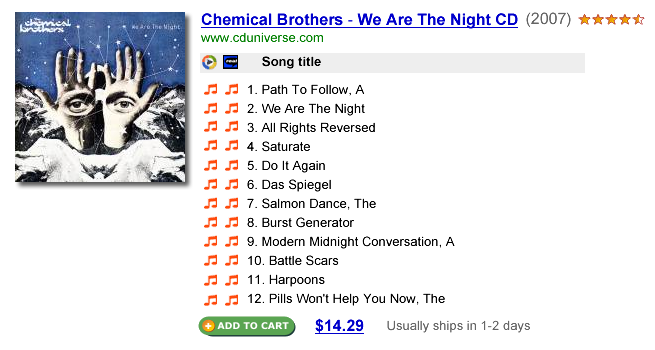توضّح هذه الصفحة كيفية تخصيص مقتطفات النتائج لموقعك الإلكتروني. لعرض مقتطفاتك المخصّصة، يجب إضافة بيانات منظَّمة إلى صفحاتك على الويب.
نظرة عامة
يساعد "محرك البحث المبرمَج" المستخدمين في العثور على الصفحة الصحيحة من خلال عرض مقتطف لهم، وهو عبارة عن عيّنة صغيرة من المحتوى تقدّم لمستخدمي البحث فكرة عن المحتوى المعروض في صفحة الويب. لمزيد من المعلومات عن المقتطفات، يمكنك الاطّلاع على مشاركة مدونة "مجموعة خدمات مشرفي المواقع" حول بنية نتيجة البحث. إذا لم تعجبك المقتطفات العادية التي تنشئها خوارزمية "محرك البحث المبرمَج"، يمكنك إنشاء مقتطفاتك الخاصة. يمكنك عرض معلومات مهمة في مقتطفاتك مباشرةً، مثل الصور المصغّرة والملخّصات والتواريخ وتاريخ المؤلف والتقييمات والأسعار. إنّ الحصول على المعلومات الأكثر صلة في نتائج البحث يجعل صفحات الويب في موقعك أكثر جاذبية للمستخدمين.
توضّح الأشكال التالية طرقًا مختلفة يمكنك من خلالها تخصيص المقتطفات في نتائج البحث.
الشكل 1: مقتطف النتيجة مع التقييم ونطاق السعر والمراجعة.

الشكل 2: مقتطف النتيجة مع التنسيق والروابط والصور ومعلومات المقارنة.

الشكل 3: مقتطف النتيجة الذي يتضمّن أنواع المستندات والمؤلفين ومرّات مشاهدة الصفحة والتعليقات.

الشكل 4: مقتطف النتيجة بتنسيق غني والذي يوفر إمكانية الوصول إلى الوسائط المتعددة وأزرارًا ("إضافة إلى سلة التسوق").

إنشاء مقتطفات منسّقة باستخدام عنصر البحث المبرمَج
ويتطلّب إنشاء المقتطفات المنسّقة بشكلٍ أساسي الخطوات التالية:
- قدِّم بيانات منظَّمة في صفحاتك على الويب.
عندما يفهرس "محرك البحث المبرمَج" صفحات الويب الخاصة بك، يتعرّف على البيانات الوصفية ويحفظها.
- يمكنك جلب هذه البيانات المنظَّمة في نتائج البحث الخاصة بـ "محرك البحث المبرمَج".
يمكن لخادم "محرك البحث المبرمَج" عرض نتائج البحث مع البيانات المنظَّمة بتنسيق JSON.
- أنشِئ طبقة عرض تقديمي لتحويل البيانات المنظَّمة إلى تنسيق HTML منسّق.
طبقة العرض التقديمي هي مجموعة من الرموز (مثل JavaScript وPHP وJSP وASP) تحوّل البيانات الأولية إلى تنسيق يتم عرضه للمستخدم. في حال استخدام "محرك البحث المبرمَج"، يمكنك إجراء ما يلي:
- استخدِم عنصر البحث المبرمَج لتحويل إخراج JSON للعرض التقديمي إلى المستخدم.
- يمكنك كتابة طبقة عرض مخصّصة لك تعمل على تحويل بيانات JSON إلى تنسيق HTML يتم عرضها على المستخدم النهائي باستخدام عمليات استدعاء عنصر البحث.
يتم توثيق عملية استخراج البيانات المنظَّمة بمزيد من التفصيل في صفحة البيانات المنظَّمة. وعند إنشاء طبقة عرض تقديمي باستخدام "عنصر البحث المبرمَج"، يمكنك الاطّلاع على مزيد من التفاصيل في صفحة عنصر البحث المبرمَج.
استكشاف ميزات أخرى
تعمل المقتطفات المخصّصة بشكل جيد مع العديد من ميزات "محرك البحث المبرمَج" الأخرى:
- للاطّلاع على مزيد من المعلومات حول تغيير ترتيب النتائج، راجِع التوغّل في تفاصيل نتائج البحث.
- للاطّلاع على مزيد من المعلومات حول البيانات المنظَّمة المتوافقة مع محرّك بحث Google، يمكنك مراجعة مقالة توفير البيانات المنظَّمة.
- للاطّلاع على مزيد من المعلومات حول "عنصر البحث المبرمَج"، يمكنك الاطّلاع على مستندات عنصر البحث المبرمَج.
